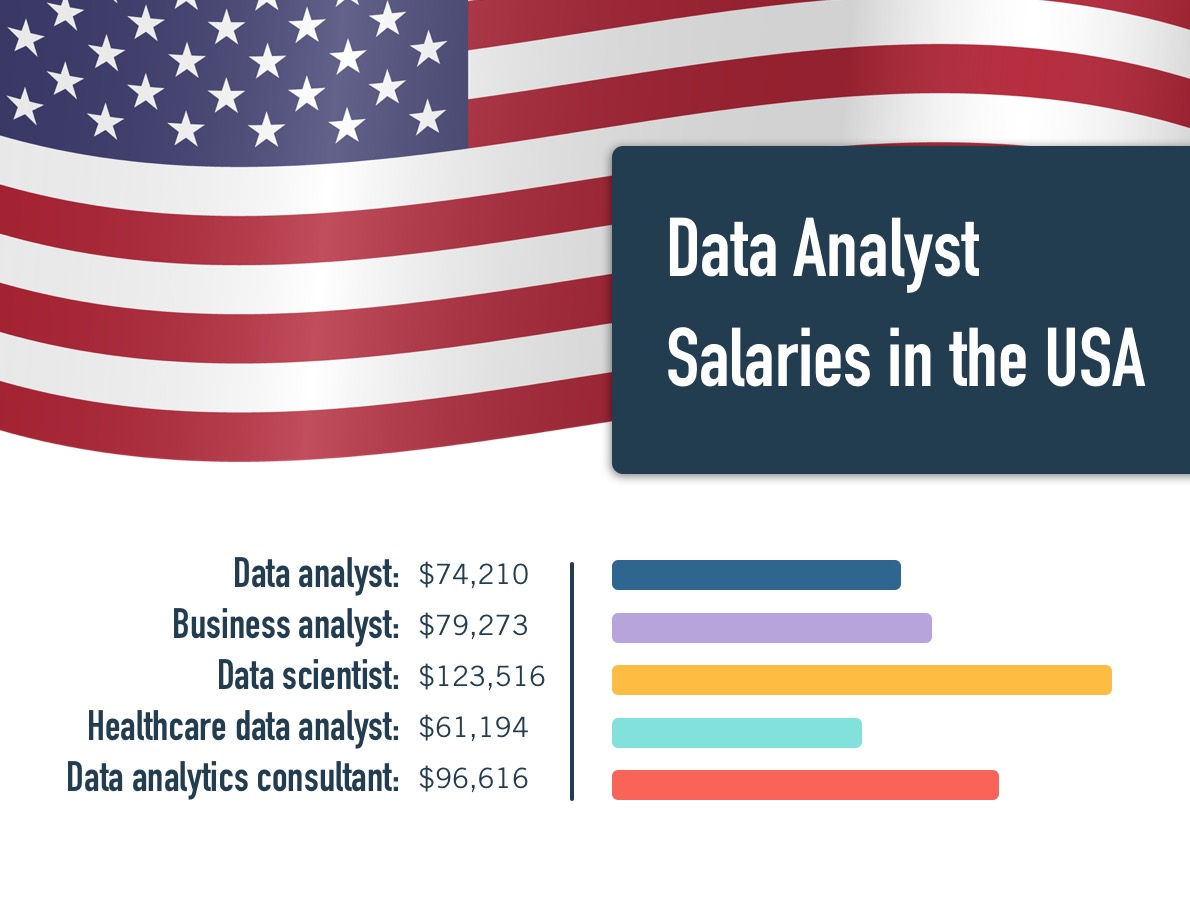What are some common data analytics jobs? Where could a career in data take you? Find out in this guide.
“Data analyst” is one of the most in-demand job titles, and you’ll find that skilled data professionals can work in almost any industry, across a wide range of organizations. As such, becoming a qualified data analyst will open the door to a highly varied and rewarding career path.
To give you a glimpse of what the future might hold once you’ve added data analytics to your skillset, we’ve compiled a list of some of the most sought-after roles within the field. We’ll explain what each role entails and consider how many years of experience you’ll need to apply for such positions—allowing you to gauge how quickly you can progress in the industry. We’ll also take a look at the kind of salary you can expect with each role.
So: Where data analytics jobs and job titles are out there? Let’s find out.

1. Data analyst
The role most commonly associated with data analysis skills is that of the data analyst. Data analysts work across a wide range of sectors, including finance, marketing, insurance, media, IT technology, and healthcare—to name just a few. When you first enter into the field, you’ll likely start as a “frontline” data analyst, responsible for extracting data, cleaning it, performing the analysis, and sharing your findings. This is a very hands-on role which will see you working closely with business stakeholders and guiding them in their decisions.
When searching for your first data analyst role, you might look specifically for junior or entry level positions. However, it is also possible to go straight for the data analyst title; many companies are willing to provide on-the-job training, especially in light of the data talent gap. Once you’ve acquired between two and three years’ experience, you can start to consider more senior roles. We’ve outlined the typical requirements and salaries for each of these levels below.
Entry level or junior data analyst
- Years of experience required: Entry level or junior data analyst positions generally don’t require any industry experience, as long as you have the right mindset and have learned the fundamentals (such as Excel, mySQL, and Python).
- Salary: The average salary for a junior data analyst in the United States is $57,947 USD (based on data from indeed.com). This is already considerably higher than the national average salary of $49,764 USD per year in the United States.
Data analyst
- Years of experience required: Data analyst positions may require anywhere between six months and three years of experience, with the exact requirements varying depending on both the company and the sector.
- Salary: On average, data analysts earn $75,286 USD per year (indeed.com).
Senior data analyst
- Years of experience required: Data analysts can progress to become senior data analysts in as little as two or three years in the field. As a senior data analyst, you’ll take responsibility for defining best practices for data analysis and working with stakeholders to determine key performance indicators for the company as a whole.
- Salary: The average base salary for a senior data analyst in the United States is $96,970 USD (indeed.com).
2. Business analyst
Another popular role requiring data analysis skills is that of the business analyst. The data analyst and business analyst job titles are sometimes used interchangeably—especially in smaller companies—but there are some notable differences. We’ve covered the differences between a data analyst and a business analyst in this post.
In larger organizations especially, they tend to comprise two separate positions. The primary focus of a business analyst is to analyze and optimize the overall functioning of the business. This might include evaluating an existing business model, determining how best to distribute employees across the organization, and investigating where expenditure can be reduced. As a business analyst, you’ll not only be required to source and analyze data; you’ll also be heavily involved in strategic decision-making and shaping the overall direction of the company.
Business analyst roles generally require at least one year of experience, but again this varies from company to company. You might choose to move into a business analyst role once you’ve gained some initial data analytics experience. The average salary for a business analyst in the United States is $79,996 USD, and you can find more in-depth salary insights in this complete business analyst salary guide.
3. Data scientist
Data scientists are in high demand, and with an average base salary of $122,450 USD, this is one of the most well-paid job titles on our list. The transition from data analyst to data scientist is not linear—these are two separate roles, after all—but, if your long-term career goal is to become a data scientist, mastering data analytics is certainly the first step.
So what does a data scientist actually do? Much like data analysts, data scientists are experts in collecting and analyzing data in order to derive meaningful and actionable insights. In addition to data analytics, data scientists possess advanced programming skills and expertise in machine learning. While data analysts identify trends and patterns in order to answer specific questions, data scientists design new processes for data modeling, write algorithms, and devise predictive models in order to estimate future outcomes. Just like data analysts, data scientists might choose to specialize in a certain domain, such as finance. You can learn more about what a data scientist in the financial industry does here.
Data scientist roles usually require at least two or three years of experience. Once you’ve mastered the fundamentals of data analysis and gained some hands-on experience, you’ll need to delve deeper into programming, machine learning, and algorithms in order to make the transition. You can learn more about the difference between a data analyst and a data scientist here.
4. Healthcare data analyst
Big data and data analytics have had a major impact on the healthcare industry, and this is a sector where skilled data analysts can bring immense value. In fact, “healthcare data analyst” has become a job title in its own right. Sometimes referred to as “the business side of medicine”, a job in healthcare analytics will see you providing physicians, clinical researchers, and key decision-makers within the healthcare sector with actionable, data-driven insights. Just like data analysts, healthcare data analysts gather and analyze data in order to help organizations improve the quality of care provided to patients.
According to PayScale, the average salary of a healthcare data analyst is $61,194 USD. Most healthcare data analyst positions require at least one or two years of experience, but this doesn’t necessarily have to be within the healthcare sector. Again, this is a highly rewarding role to move into once you’ve gained some initial data analytics experience.
5. Data analytics consultant
If you’re hoping to build a career which allows you to work flexibly while offering more variety than an in-house role, you might consider becoming a data analytics consultant. Data analytics consultants are just like data analysts in the work they carry out and the insights they provide, but rather than working in-house for one company, they either work for an agency or for themselves on a freelance basis.
On average, data analytics consultants earn $96,616 USD per year in the United States. To be a successful consultant, you’ll need a few years of experience behind you—but again, there is no hard-and-fast rule. You might choose to specialize in a certain industry, or to remain diverse in the types of clients you take on. That’s one of the great benefits of working in data analytics—it’s applicable to virtually every industry, so you can forge your career based on your own areas of interest and expertise.
What now?
In this post, we’ve outlined just five of the most rewarding, well-paid, and sought-after job titles you could end up with once you’ve honed your data analytics skills. This list is just the tip of the iceberg; a career in data analytics offers endless variety, and there are opportunities in practically every sector imaginable. Check out the role of the operations analyst or big data engineer, for example, or browse “data analyst” roles on sites like indeed and LinkedIn and you’ll soon see what we mean!
Want to know if working in data analytics is the right career path for you? Check out the following video from CareerFoundry’s in-house data expert, Tom, who shares his advice on the topic:
For a hands-on introduction to the field, try out this free five-day data analytics short course. If you’re ready for a comprehensive course, you’ll find a thorough comparison of the best data analytics certification programs on the market here. And, for more insight into what a career in data analytics involves, check out the following:
